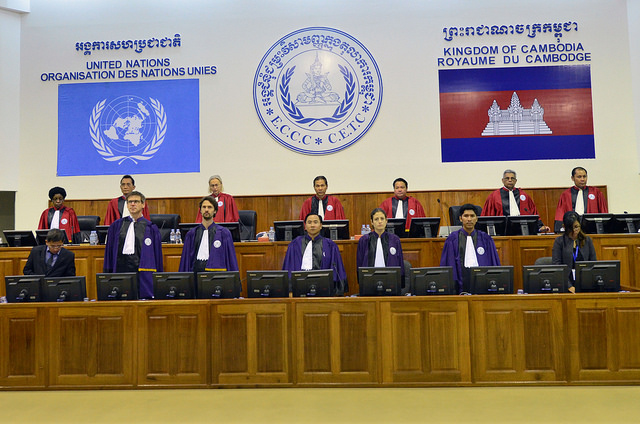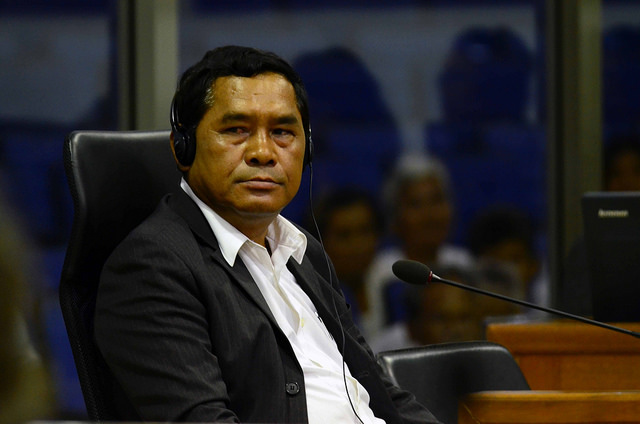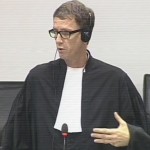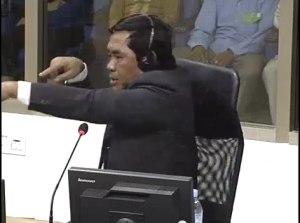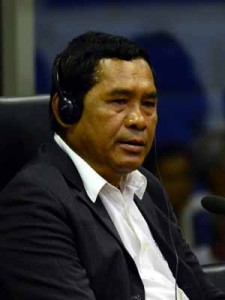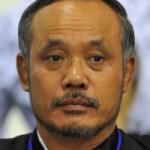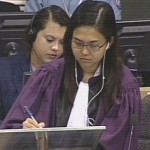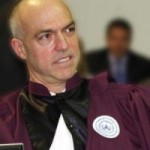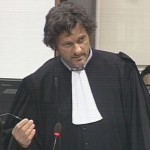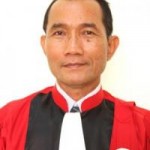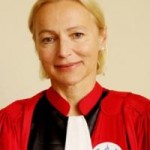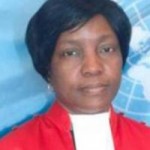“He’s lying from A to Zed” – Defense On Second Witness Of Appeal Hearings
On July 3rd the appeal hearings for case 002/01 continued into their second day out of three. The Supreme Court chamber heard the testimony of witness SCW-3, Mr. Sâm Sithy. (For background on case 002/01 and the appeal hearings, please refer back to the introduction of yesterday’s post).
Nuon Chea waived his right to be present due to back pain as has been his custom. (Yesterday, surprisingly, he attended the first session). There were ten civil parties present in the court room.
In the 270-page appeal, the defense for Nuon Chea explained why this witness is important to them. In paragraph 595, Nuon Chea’s defense notes that the Mr. Sithy’s testimony was the “only WRI which contains any evidence of any significance” related to the killing of Lon Nol Soldiers. The appeal also alleges that the person who interviewed Mr. Sithy had been responsible for the interview of another witness which, allegedly, was shown to be “completely erroneous” during cross examination. Finally, the appeal notes that if Mr. Sithy is not summoned to the Supreme Court Chamber pursuant to its de novo jurisdiction “the Trial Chamber’s reliance on his WRI . . . constitutes an error of both law and fact.”
Mr. Sâm Sithy (witness SCW-3) summoned by the Supreme Court Chamber, took the stand.
Mr. Sithy, alias Thy, was born on the 15th of May of 1961 in Rolea B’ier District in Kampong Chhnang Province. He is a police inspector of Kampong Chhnang town. His father is Sam Oeun and his mother On Ni and they’re both deceased. His wife’s name is Prak Saoni.
It was not clear whether Mr. Sithy had applied to be a civil party at some point. It was also not clear whether he had been interviewed by the OCIJ or “a working group,” as Mr. Sithy kept calling it, whose “role was to find witnesses for crimes occurred during the Khmer Rouge.” Mr. Sithy said that he had not appeared before the Trial Chamber.
The floor was first given to the defense team for Nuon Chea. Mr. Victor Koppe took the lead.
Two or Seven Years Ago?
Mr. Sithy told Mr. Koppe that he had been interviewed a “little bit more than a year ago” at his police office in Kampong Chhnang town in 2014. Mr. Koppe was puzzled as he only had a statement that dated from seven years ago and asked the prosecution if there was a second statement. Mr. Nicholas Koumjian, International Co-Prosecutor, says that they were not aware of a second statement but that Mr. Koppe could ask about the attachment. Mr. Koppe said he would move on and asked if Mr. Sithy had also been interviewed seven years ago.
Mr. Sithy said he had provided a statement to a “working group” where he had described his experiences during the “three years eight months and twenty days” of the regime. He did not confirm when he gave this statement.
When Mr. Koppe attempted to show the Khmer version of that statement to see if Mr. Sithy recognized his own signature, Judge MONG Monichariya interrupted to ask Mr. Sithy how many times he had been interviewed.
Mr. Sithy said he had only been interviewed once and now told the judge that he had given the statement two years ago.
The President of the Supreme Court Chamber, Judge KONG Srim, allowed Koppe to show the document to Mr. Sithy. Mr. Sithy confirmed that his thumbprint and “the handwriting underneath” were his, notwithstanding the request for clarification from Ms. SONG Chorvoin, Deputy Co-Prosecutor, where she said that the Khmer had no signature but just a thumb print.
Mr. Koppe pointed to the first sentences of the first page of his statement that said he had been interviewed seven years ago on the 7th of August of 2008. Mr. Sithy insisted that it was not seven years ago but that it was two years ago. When he insisted that it was only two years ago and that he did not agree that it was seven years ago, Mr. Koppe said “that is highly problematic.”
Mr. Koppe proceeded to ask if he remembered anything about a battery problem for the recording machine when he was interviewed. Mr. Sithy did not recall any details about the equipment. Mr. Sithy said he did remember reviewing it after the interview and that it was consistent but he hasn’t read it since, but he believed it was still consistent.
Mr. Koppe went back and asked him one more time if Mr. Sithy insisted that it was two years ago and not seven. Mr. Sithy again confirmed it was two years ago. Mr. Koppe said, for the record, that he had just been informed that the document creation date was October 1st 2013, “strangely enough” but that he would move on in the interest of time.
Evacuation
On 17 April 1975, Mr. Sithy said he was forced to evacuate his house and sent to a mountainous area. There he said he heard an announcement that asked former soldiers and civil servants to register their names so they could get rice and then they would be allowed to return to their previous jobs. “After those people obtained rice, they were taken away and killed,” Mr. Sithy said, “they were all killed.”
Mr. Koppe tries to get him to be more specific about the first week after April 17, 1975.
Mr. Sithy said he walked on foot. People were evacuated and if they didn’t follow the instructions their lives would be at risk because of the American planes that would bomb the area, Mr. Sithy said. And he sad that for that reason they packed up and left.
When Mr. Koppe asked him if he had left together with his parents and siblings, Mr. Sithy said out of his family of four younger siblings and two parents, his two parents and his two younger siblings were killed. He said that one of his younger siblings was a teacher and “him and his entire family was killed.”
Family was killed
Mr. Sithy then said : “At that time I was 14 or 15 years old and I pretended to be dead among the corpses of members of seven families. The members of the seven families were ordered to sit in a group and they fired at us to kill us all.”
Mr. Koppe asks Mr. Sithy to bear with him and that he will get to that later. He asks again about what happened after April 17, 1975.
Mr. Sithy said he left his village and went to Chrek Sdek Pagoda and it took them ten days. He said they stopped at Klong Popok Pagoda for lunch time on the way. Then they went to Phnom Chrey Mountain and then they went down the mountain to be placed in cooperatives and reached Wat Chrek Sdek.
He said that when he reached that Pagoda he had ran out of rice and someone from the regime that lasted “three years, eight months and twenty days” told them that if they registered their names they could get rice and go back to their jobs.
He then explained that after they got the rice, at around 1 p.m. they were led to their respective cooperatives.
After they reached Prey Rongkla (phonetic) they left their belongings on the side of the river.
“When we reached that place, there were armed forces,” Mr. Sithy continued. “We were asked to sit in one group and those soldiers shot their rifles at all of us.”
“As for the baby, the baby was hanged from its leg and killed,” Mr. Sithy said.
“And the corpses and bodies were thrown into pits covered with leaves,” Mr. Sithy continued, “and after they did such act, soldiers left the place. At that time I did not die. I pretended to be dead. I was pulled and thrown into the pit full with leaves. It was raining. After they left, I crawled out of the pits. Four people survived –some were injured on the head and some had broken ribs– and we left the pit together.”
When he got pack to a pagoda, Mr. Sithy said that there were relatives and neighbors who knew that he had been led to the pits to be killed and that his parents had been killed already.
“And during that time guards tried to search for the four of us who had survived the killing. In the evening, the members of the armed forces went to different places,” Mr. Sithy said “and people at that time tried to go the places that they wanted and the militia man could not control the situation and we left in groups.”
Mr. Koppe lets Mr. Sithy finish and asked him to please stay with the chronology, and asked him again what he had see when he had first arrived at the Wat Chrek Sdek.
“Did you see thousands of people? What did you see when you arrived there?” Mr. Koppe asked.
Mr. Sithy said that the Pagoda was the place where members of Pol Pot gathered together. “As I stated earlier,” Mr. Sithy continued, “some people were bicycle drivers but in order to get the rice they registered as former soldiers.”
Mr. Koppe asks the President for assistance. Mr. Koppe says that it seems that he is unable to convince the witness to answer his questions. Mr. Koppe then asks, for the third time, “what did you see when you arrived at the Pagoda?”
Mr. Koumjian tries to help by saying that it might be helpful to specify which time of arrival at the pagoda Mr. Koppe is referring to. Mr. Koppe says that he thinks he has been very clear. The President, Judge KONG Srim, interrupts and asks the witness to listen to the questions and asks Mr. Koppe to ask short questions.
Mr. Koppe asks for the fourth time. “What did you see at the pagoda when you arrived the first time?”
“When I reached the Pagoda I saw many many people. And I saw members of Pol Pot forces there,” Mr. Sithy answers, “there were many thousands of people.”
When asked to explain what happened that day and the day after, Mr. Sithy said that
on that day there was an announcement that was made over the loudspeakers aimed at searching for officers and former officials so that they could get rice. While the announcement was being made, names were being registered.
“They told lies to all of us: that we could go back to work,” Mr. Sithy said.
Father registers as former soldier
Mr. Sithy said that his father, who had been a soldier during the Lon Nol regime, registered his name and his former occupation. His father wore paramilitary trousers and a white shirt, Mr. Sithy recalled.
Then the names of the family members of the people who had been registered were called, Mr. Sithy said. They were given rice and then they were led southwards from the pagoda. They were told they were to find houses to live in “but they were all killed.”
Southwards or Northwards?
Mr. Koppe then confirms that Mr. Sithy had said that they were led southwards towards Prey Rongkla (phonetic). Mr. Sithy says yes. Mr. Koppe then asks if it is not true that in fact, Prey Rongkla is 70 kilometers northward of Wat Chrek Sdek.
Mr. Sithy insists that it is not correct.
Killing site revisited
Mr. Koppe then asks how many people did he walk with southwards, as he insists. Mr. Sithy says there were seven families with an average of seven people per family, but he cannot remember their names.
Mr. Sithy recalled that one family had a member who was a civilian medic, another had a member who was a teacher and for the rest, at least a member of each family was a soldier of the Lon Nol regime.
Mr. Sithy then says that they were escorted at gunpoint. They were told that if they tried to escape they would be shot. Then at a certain location they were all ordered to sit. There was no discussion at all because “we were not armed.”
Before that, they were told to leave their belongings on the north side of the river and cross a river. Afterwards they were led at gunpoint to the killing site.
Then they were all ordered to sit in a group.
“When we were ordered to sit a group,” Mr. Sithy said, “they stayed back and then they all fired upon us. And as for the young children who were not hit by bullets, they would go around and pick them up and smash them.”
Mr. Koppe asks whether is true, as he had testified earlier, that the women and men had been separated. Mr. Sithy confirms that the men were told to cross the stream first and then the women and children.
Mr. Sithy said that he crossed the river with his father and saw the men being led away and killed (later he said that what he saw was a man with a long knife). But, he said that because he was young, he was chased away and was able to return to his mother to the other side of the river and tell the group of women and children about it, but they did not believe him. He then said that, after they had killed the men, the women and children were taken to the same place and executed.
Is he making up the story?
Mr. Koppe says that he is not sure he follows the witness. He tells the Bench that this witness, at least in his perspective, has been so evasive in his answers and asks for more time.
Mr. Koumjian says that the prosecution “heartily disagrees.” Mr. Koumjian says the witness has not been evasive at all and is telling his story. He also says that the questions that are being put to him are compound and complicated and has no objection to giving no objection as “it doesn’t hurt us at all.”
The President says that the answers from the witness have been clear enough and notes that the Chamber’s observation is that the questions from Mr. Koppe have been repetitive, but grants him ten extra minutes.
Mr. Koppe says that “that is not very fair.” He insists that he’s not asking repetitive questions. “It is our position that he’s making up this story and the only way to establish this, is to find details that are convincing, ” Mr. Koppe replies.
Mr. Koppe continues.
“What happened when you were being shot at?” Mr. Koppe asks.
“After they fired the shots at us.. I pretended to be dead.. then we were dragged into the pit….that is including other corpses and myself.”
“How did you play dead?” Mr. Koppe asks.
“I pretended to be dead, because I had seen what happened to my father’s group . . .that’s when I ran back…”
The President interrupts and asks the witness to answer to the point. The question was, the president says, “how did you pretend to be dead?”
Mr. Sithy answers: “My mother was sitting in front of me and when a bullet hit her chest, she fell to the ground and I fell to the ground as well. So everybody fell to the ground as well, and they went around smashing the heads of young infants to made sure they were dead.”
Mr. Sithy then said he played dead for maybe two hours.
“How did you, and your younger sister, and your two cousins, fool these soldiers?” Mr. Koppe asks.
“It was about to rain and it was about to get dark and they did not have that much time,” Mr. Sithy responded, “Actually they did not complete their job properly. If they were to do their job properly they would drag us one by one and finish us off if they were to make sure that everyone of us was dead. They hurried to finish us off and go to collect our belongings.”
Mr. Sithy then explains that the pit was an existing a B-52 crater. They threw them into the pit and they put tree leaves on top and left the dead bodies there.
Mr. Koppe then attempts to asks if the witness has an explanation for the fact that Dc-Cam only found one mass grave site in the West Zone, which is indeed in that area but it’s 70 kilometers north of Wat Chrek Sdek.
“It is my strong conviction that he’s lying from A to Zed,” Mr. Koppe says.
After strenuous objections from Mr. Koumjian on the grounds of speculation and Ms. Guiraud as to where Mr. Koppe is getting the information of the 70 kilometers (Mr. Koppe says Google Maps, it’s 2015 – a claim that could not be independently verified by this writer), and some help from Judge Milart, Mr. Koppe withdraws his question.
When the President asks if Mr. Koppe has any more questions, Mr. Koppe says:
“About a thousand, Mr. President, I need about two more hours. Ten minutes is ridiculous.”
While the bench seems to sit in stunned silence, Mr. Koumjian rises and says that perhaps if Mr. Koppe could indicate his more important question, the Court could at least give him the chance to ask it.
“If it goes like this,” Mr. Koppe responds, “I remove all my questions.”
The court breaks.
__
After the break, Mr. Koppe apologizes for loosing his temper and continues. (But, after just 9 minutes and 44 seconds the video breaks off. In the public videos uploaded by the court, there seems to be a mistake and the ones from the day before were uploaded instead of the ones from session two for July 3rd (the public affairs section of the court has been notified). As such, as of this writing, there is no public record of session two which I believe consists of the end of the examination of Mr. Koppe and the beginning of the examination by Mr. Vercken).
After lunch, the floor is given directly to the civil parties and prosecution, although the defense for Khieu Samphan was under the impression that he would be given more time. The President explains that the Bench has decided to hand the floor first to the Civil Parties and prosecution, and if there’s time, it will be given back to the defense.
Mr. HONG Kim Suon, Civil Party Co-Lawyer, took the floor.
Mr. Sithy, the witness, first confirms that the evacuation from his home was not voluntary, and he believes “that the principle was set forth by Pol Pot.” He said that during the evacuation people did not have food to eat and some people fainted. He added that there was no medical assistance.
Mr. Suon then moves on to ask about how many people registered at the Wat Chrek Sdek as being former civil servants or soldiers of the Lon Nol regime. Mr. Sithy cannot recall how many but says that “usually those who had no food or had run out of food would register.”
Mr. Sithy is then asked whether he remembers hearing anything from the Khmer Rouge who killed his family members. Mr. Sithy remembers that, when he had opened his eyes a little before he was dragged to the pit, the soldiers said : “You, you contemptible you. You stepped on my chest for many years, now it is our turn to step on your chest.”
Mr. Sithy also confirms that, after he and his sister and two cousins returned from the killing pits, the Khmer Rouge announced on the loudspeakers that there were four kids with links with the CIA that they were looking for.
Mr. Sithy then says that his father was a captain in the Lon Nol Army.
Mr. Suon ends his examination by asking whether Mr. Sithy has had any news about his father since 1979. Mr. Sithy says that no he hasn’t received any news and that he never looked for him as he was sure he was dead.
Ms. SONG Chorvoin, Deputy Co-Prosecutor, then took the floor.
She starts by asking the witness Mr. Sithy to react to the defense’s statement that his whole story was a fabrication.
The witness responds that it is not a fabrication and that he witnessed the events personally. Mr. Sithy adds that he took an oath before the iron-clad statute and that he will only tell the truth. Mr. Sithy insists that the shooting of his family is the truth and that “I will not add anything to it” and that he has a “strong belief” in the oath that he took and he will only tell the truth based on what he saw and what he knows.
Ms. Chorvoin then asks about what happened after his family was killed. Mr. Sithy says he was sent to Krang Leav commune where he was placed in a children’s center where he was asked to deal with the production of fertilizer. Mr. Sithy says that he did not make any mistakes when he worked in the children’s unit as he “knew what would happen.”
Mr. Vercken, defense counsel for Khieu Samphan, objects to this line of questioning as, according to him, it is outside of the scope of the trial and because he believes the prosecution is using time up with the purpose of not leaving enough time for the defense. This is due to the fact that the Bench promised the defense that if there was time left after the prosecution they would be given some time. The President takes note but overrules the objection. Ms. Chorvoin continues but first responds that if she is not interrupted there might be time left for the defense.
Mr. Sithy says that he saw children beat in the cooperative and he warned his sibling and cousins to be careful as “they were still looking for us because we were the children of the former soldiers who had been killed.”
There was an aside about Krang Leav Security Center to which the defense strenuously objected but the Bench overruled them. The decision of the bench was based on the presumption that the line of questioning was within the temporal jurisdiction of the appeal (75-77) and the prosecution was testing the credibility of the witness.
Then, Mr. Nicholas Koumjian, International Co-Prosecutor, took the floor.
There was an aside (to which both defense counsels objected) about a secret office B-5 (where allegedly Pol Pot had gathered close to April 17, 1975) but it is not clear whether that was close to the Wat Chrek Sdek that the witness had mentioned. Mr. Sithy just confirmed that Wat Chrek Sdke was in Peam commune. It was not clear from the hearing, without having access to the documents that were being mentioned, whether B-5 was in the same commune or not.
Mr. Koumjian took the witness back to the evacuation. Mr. Sithy explained that Khmer Rouge soldiers dressed in black and armed with rifles went from house to house evacuating people. “No one dared refuse,” he said. He remembered that the Khmer Rouge soldiers told him that they had to leave because there were American bombings on their way.
When Mr. Koumjian continues asking the witness about the evacuation, Mr. Koppe rises to say that apparently the prosecution has not finished reading their appeal brief where they don’t contest any of the forced evacuations from any city. Mr. Koppe says that “not one question has been asked about why this witness is here” and that the prosecution is merely “stealing proper time” away from the defense.
Mr. Koumjian responds that it was his understanding that any question related to case 002/01 could be asked. The President allows him to proceed.
After some questions on the evacuation, Mr. Koumjian asks Mr. Sithy to explain why his sister died.
Mr. Sithy explains that he believes it was due to the trauma of her being hit on the back of her head (presumably during the massacre of their parents). Mr. Sithy said that he thinks this led to her having a “psychiatric condition” that led her to become unstable and to commit suicide a few years ago.
Mr. Koumjian then asks about the cooperatives when Mr. Sithy arrived at Krang Leav commune. Mr. Sithy explains that “New People” and “Base People” ate different rations of food. He also says that “Base People” supervised “New People.” Mr. Koppe objects again but it is quickly overruled.
After some more questions on the cooperatives, Mr. Vercken objects because he believes that the questions from the prosecution are outside of the scope of the appeal, that there has been severance, and that “we are going in all different directions without purposes.”
Mr. Koumjian responds that the basis of the convictions on case 002/01 was based on the Joint Criminal Enterprise and various policies where enslavement was practiced in the cooperatives. Mr. Koumjian believes he should be allowed to ask these questions.
Mr. Koppe responds that the prosecution is making a mockery of this appeal and it is a disgrace and asks the Bench to “please intervene.”
Judge Milart notes that there is no mention of the cooperatives in the judgment of case 002/01 and that it is not the appropriate use of the time in the area of relevance. (Later on Mr. Koumjian says that paragraph 615 of the judgment does mention the words cooperatives).
Mr. Koumjian moves on and asks about the term “enemy.”
Mr. Sithy explains that being an “enemy” meant making any mistake. For example, he says, eating a potato that you yourself planted, would be considered a mistake that would label you as an enemy.
(The last part of Mr. Koumjian’s questioning is not translated into English in the videos that are public online as of this writing; the public affair section of the court has been notified).
__
After a break, the Bench gives defense counsel an additional thirty minutes. Mr. Vercken, lawyer for Khieu Samphan, takes the floor first.
Mr. Sithy now says that he now remembers being interviewed twice, two years ago, and seven years ago. He doesn’t know, though, whether he was interviewed by the Court or some other organization one of these times.
Mr. Vercken then reads back from Mr. Sithy’s OCIJ interview and asks why he didn’t run away after he heard the gunshots.
Mr. Sithy explains that he didn’t escape because there were two armed militia men (with knifes) watching over the women and children Additionally, he said his mother still believed that his father had gone to go cut wood. Then he said that his mother, when they heard the gunshots, told him that it was just the hunting of wildlife. Mr. Sithy explained, though, that he knows that the hunting story was a lie so that he wouldn’t be scared. Mr. Sithy also told the Chamber that he tried to escape twice and his mother caught him and brought him back twice.
When asked if he was naked when he escaped from the pit, Mr. Sithy explained that he witnessed that the clothes of the adults had been removed even though they were stained with blood. He said he doesn’t know why they didn’t take of his clothes or those of his siblings. He thinks it is because they were too small.
Mr. Vercken then asks how the Khmer Rouge knew that four children had survived.
Mr. Sithy explained that when he got back, he told his relatives that they had survived and that the word-of-mouth spread until everyone knew.
Mr. Vercken insisted that Mr. Sithy had said before that, once him and his three relatives returned, people already knew they had survived. Mr. Vercken insisted on the word “already.”
Mr. Vercken then says that no one in the case file has talked about the Chrek Sdek Pagoda and asks him to name other people who were at that Pagoda who are still alive today.
Mr. Sithy says that there are some of his relatives who are still alive today. Mr. Vercken insists on their names, and Mr. Sithy says that he cannot do that as he doesn’t know their real names.
—
The defense rests and the Bench takes the floor.
Judge SOM Sereyvuth takes the floor first. He asks the witness Mr. Sithy to confirm that there were 37 members in the seven families that were killed and that there were six armed men with rifles.
Mr. Sithy explains again how they were killed by gesticulating around the room and pointing around him and said: “The six armed were surrounding us and fire was opened at us. . . No one dare escape.”
Judge Milart asks him to tell or show the Court from how far away the six armed men were shooting at his group. Mr. Sithy says the shooting was from about eight meters away. When pushed by Judge Milart to point at a place in the court room, taking himself as reference, he says it is about the place where the corners of the defense teams are sitting.
He tells Judge Milart again how the six or seven men surrounded them and started shooting. He estimates that it took half an hour, including the time that they went around and smashed the young babies. He says the shooting only lasted fifteen minutes.
Mr. Sithy then explains that the shooting happened in series, not all at once. “If someone stood up, they shot at them,” he said.
“After the shooting stopped, no moaning, only the cries of the children were heard,” Mr. Sithy explained.
“I understand,” Judge Milart says and cedes the floor.
Judge Florence Ndepele Mwachande Mumba asks about his education level when he had been evacuated. Mr. Sithy explains he was in grade eight, but that the old education system was in reverse order: you started at grade twelve and went back to level one. He then explains that he had been in school for eight years because he failed grades 12, 11 and 10. After 1979 Mr. Sithy did not pursue any further education.
Judge Chandra Nihal Jayasinghe, then asked how his family had sustained itself after the evacuation on the way to the pagoda. Mr .Sithy explained that his parents cooked for him.
Judge YA Narin asked about the traveling conditions during the forced evacuations. Mr. Sithy said it was very crowded and people moved very slowly.
Judge Milart then asks about what prompted the article that brought the investigators in the first place. Mr. Sithy explained that he has a friend in the press that knew his story and convinced him to give an interview. Mr. Sithy says the name of the interviewer is Ian.
The court adjourned and the last witness of these appeal hearings, SCW-5, will be heard on Monday July 6, 2015.

